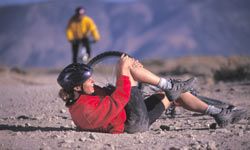On the whole, Americans are a fun-loving bunch. A more contemporary work-hard, play-hard attitude has replaced the old Protestant work ethic. And if the numbers coming in from emergency rooms are any indication, Americans are indeed playing hard -- very hard.
Roughly 14.7 million visits were made to the ER in 2010, the most recent year for which data are available [source: CSPC]. And 4.1 million of those visits fell under the sports and recreation category [source: NEISS].
Advertisement
So what are the five most dangerous recreational sports? Any sport can cause injuries, and we've all seen them happen -- to ourselves, our favorite pros and unlucky YouTube stars -- but we wanted to base this countdown on hard data, not hearsay. This article uses information from the National Electronic Injury Surveillance System, created by the Consumer Safety Product Commission to collect information from ERs across the country.
The commission originally created the NEISS to track injuries related to consumer products, but because of its usefulness, the system expanded to cover all injuries beginning in the year 2000 [source: CSPC].
"The National Electronic Injury Surveillance System is a statistical sample of approximately 100 hospital emergency departments in the U.S. open to the general public," said Thomas Schroeder, director of the CSPC's Division of Hazard and Injury Data Systems. "Data are collected from participating hospitals on a daily basis for consumer product-related injuries treated in the emergency department" [source: Schroeder].
And before you start thinking "snow skiing," remember, this list is based on the number of injuries reported at ERs. While skiing is indeed a dangerous sport (103,274 ER visits in 2010), not as many people participate in it as compared to more common sports like football.
"Every sport involves some risk, and there's no way around that," says L. Syd Johnson, a professor of kinesiology and integrative physiology at Michigan Technological University. "But sports are also a fun and interesting way to stay healthy and fit" [source: Johnson].
Before you get out those sweatpants and rush to the park, let's find out what made the list of the five most dangerous rec sports. We'll count down from No. 5: an off-road activity that could leave your head spinning.
